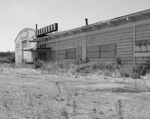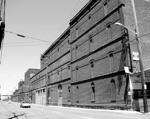Most days, my work schedule starts at 1pm. Occasionally, though, if we’ve had a slow week and need to save a little money on our payroll, I’ll be scheduled to start my day an hour later. Yesterday was one of those days — unfortunately, I didn’t realize this until I walked in the door and my manager laughed as he saw me walk in.
“Didn’t check the schedule, did you?”
“Argh — two o’clock?”
“Yup.”
Not a problem, though, as I simply dropped off my bag in the breakroom, grabbed my camera, and ducked out the back door to explore Georgetown for an hour. I’ve been working on poking around the neighborhood when I get the chance, usually on days like this one where I have some time to kill before work. Yesterday, starting from just by where exit 162 from I-5 empties out, I crossed Michigan and started following Corson to see where it went.
Georgetown’s an interesting little area of Seattle, though apparently relatively unknown to a good part of the city, as I’ve gotten more puzzled looks than anything else when I mention that I work in the area. Tucked in between I-5 and the Duwamish River and just north of Boeing Field, it’s not much to look at as you drive by on the highway, just another relatively anonymous strip of warehouses and industrial complexes, some bustling with activity, and some abandoned, waiting for new development or the inevitable march of time to pull them down.
But start wandering the streets, and you’ll find a lot of life hidden in the nooks and crannies of this seemingly barren area. The Georgetown residents that come through my work are generally rather proud of their little section of Seattle — and there’s a lot of history here to be proud of. Seattle’s first settlers arrived in what became the Georgetown area about a week before the Denny party arrived, though it was the Denny party that has received the lion’s share of the credit for founding Seattle. The Seattle Brewing and Malting company (later to become Ranier Beer) got its start here, as did Seattle’s first railroad. The first powered airplane flight in Seattle took off from Georgetown’s Meadows Race Track.
Increasing industrialization and the construction of the I-5 highway prompted the gradual decline of Georgetown through the latter half of the century, but long time residents never lost their sense of community, and the neighborhood has been showing more signs of life in recent years. Relatively cheap housing and warehouse space has led to a number of artists setting up shop in the area, mixing in with the already existing industrial businesses, and I’m often amused by the mix of customers that come wandering through my store. During the day we get primarily white- and blue-collar businesspeople working on business proposals and engineering plans, but once the business day ends the clientele becomes dominated by local artists working on their latest creation, punk bands creating flyers for local shows, and political activists out to change the world. It’s a fun mix.
I followed Corson down to where it hits East Marginal Way, then crossed Marginal and followed 8th Avenue until it ended at a tiny little park overlooking the Duwamish. A small trail led me down to an outcropping of mud and debris jutting a little way into the river, and I took a few moments to stand next to a rotting pier and watch the river roll past. A barge was moored across from me, idle cranes on the shore stretched overhead. Geese idly paddled back and forth just off the bank, bobbing up and down on the wake from a passing private motorboat.
Turning, I climbed back up the hill and found a small memorial stone bench on the crest, overlooking the river. Later that evening, discussing my wanderings with one of my customers, I found out that the inscription on the stone was dedicated to Tim O’Brian, something of a local Georgetown celebrity who fought hard to preserve the neighborhood, its buildings and the river, who passed away just a few years ago. “You found a great piece of this funky little neighborhood,” she said, smiling as she turned to leave the store. “Keep exploring.”
I plan to.
(Cross-posted to Seattle.Metroblogging.)
iTunes: “Riverhead” by Prick from the album Prick (1995, 4:39).




